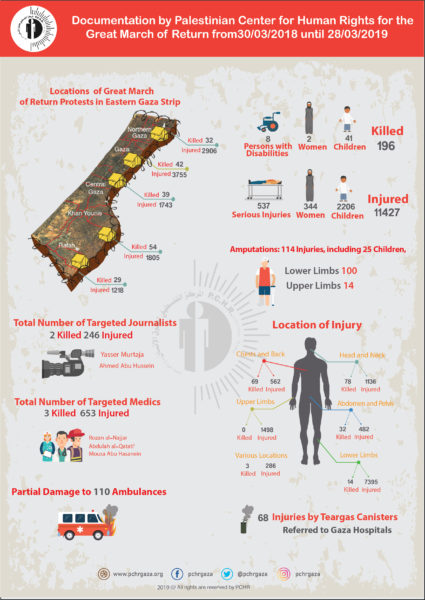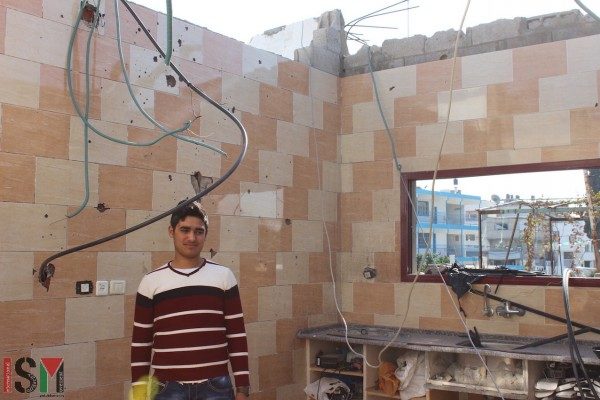August 25, 2019 | International Solidarity Movement | Gaza, occupied Palestine

Eleven consecutive weeks of protests in Hong Kong have captured the focus of online commentators, heads of state, and global media. In France, 39 weeks of protests by the Yellow Vests movement continues to garner widespread interest. In the US, Occupy Wall Street is now an international household name after occupying Zuccotti Park for 9 straight weeks.
Last Friday marked the 71st week of the Great March of Return protests in Gaza, a staggering 1 year and 4 months of weekly demonstrations that have become largely forgotten in the amnesic world of headlines and social media.
The protests began to demand the right of return for Palestinian refugees and an end to the 12-year-long Israeli blockade of Gazan economy and society. Friday’s protests, titled “Protests for al-Aqsa Mosque” took place in Abu Safiyah, Gaza City, Bureij, Khan Younis, and Rafah. Once again, for the 71st week in a row, the Israeli army responded with undue force, spraying non-violent protesters with live ammunition, tear gas and rubber-coated steel bullets. 149 civilians were injured, including 66 children, as well as 7 paramedics. 77 unarmed protesters were shot with live bullets. On the 70th week, titled “Palestinian Youth’s Friday”, 83 civilians were injured, including 24 children. 36 civilians were shot with live bullets. The week before that, the 69th week 73 civilians were injured, including 30 children, two journalists and a paramedic. I could go on.

The Israeli Military justify their actions by claiming they are responding to protesters throwing stones, Molotov cocktails, and flying burning kites and balloons.
Since the start of the Great March of Return protests, on March 30th, 2018, the Palestinian Center for Human Rights has documented 208 Palestinian deaths by Israeli forces, including 44 children, 4 paramedics, and 2 journalists. Another 13,629 were injured, including 196 who now suffer from serious disabilities ranging from amputations, paralysis, permanent loss of sight and hearing, and other disabilities.

One might ask, in light of the brutal violence and tremendous human cost, why Gazans continue to protest every Friday, knowing the risk to their health and lives?
Maybe because Gazans don’t have the luxury of not protesting, of being able to quit and return to their “daily lives”. Maybe because while we, in the comfort and security of our homes, can choose whether or not to open a news story about protests in Gaza, Gazans must face a devastating reality; according to the United Nations Office for the Coordination of Humanitarian Affairs, 90% of Gaza’s water is undrinkable.
The rest is projected to become undrinkable due to pollution and lack of sewage treatment by 2020, at which point Gaza may become “unlivable”. Gazans receive on average of only 10 hours of electricity a day. Unemployment stands at 47% (65% amoung youth). While 75% of Gazans rely on international aid, mostly food aid, 35% of Gaza’s farmland and 85% of its fishing waters are inaccessible due to Israeli military policies. Hospitals are massively overstretched and under supplied, with one third of medicines deemed essential by the UN unavailable. 85% of schools in Gaza are running on double shifts, meaning students can only have 4 hours of classes a day.

All of these realities on the ground have been confirmed by United Nations reports, in addition to UN Security Counsel Resolution 1860 (2009), which calls for the lifting of the blockade on Gaza. Yet the international community has thus far failed to act on the resolution, or make any concrete actions to push for its enforcement, leaving Gazans no choice but to try to call attention to their plight in any way they can, regardless of the cost.
The casualties of last Friday’s Great March of Return protesters failed to capture the world’s attention. It wasn’t reported in CNN, BBC or Al Jazeera; it didn’t make news in the Times, Reuters, or RT. Perhaps, if we as individuals listened to what Gazans have been trying to say for the past 71 weeks, the international community would be forced to respond. Perhaps, if the protests in Gaza elicited the same attention as the protests in developed nations, governments around the world would take notice and maybe even take action.
Perhaps, if we stopped forgetting the people of Gaza, they would not have to put their bodies and lives on the line to make us remember.

